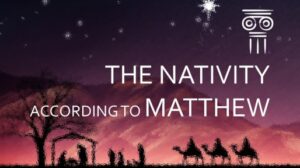Unreal Birth Circumstances – Jesus of Nazareth
Circumstances of the birth of Jesus of Nazareth are no less than incredible. A three-way confluence of events from locations in Rome, Persia and Nazareth, hundred miles apart from each other and months in the making, culminated in a small town where none of the figures of the story lived.

Two Gospel accounts cover the Nativity story, Matthew and Luke, each complimenting the other with few overlapping details. According to Luke, Caesar Augustus issued a registration decree although the Roman story behind the story is not told.
Caesar Augustus was designated Pater Patrie of the Roman Empire, Father of the County, on February 5, 2 BC, by the Roman Senate. The achievement was one the 35 highlights in The Deeds of Divine Augustus listing the accomplishments of Caesar over his 25 years of rule.[1]
To honor Augustus in 2 BC, planning began for a special registration of the entire Roman Empire including the provinces, not just the typical census for citizens of Rome. Each registrant was expected to swear an oath of allegiance to Augustus.[2]
Logistics to execute this registration decree required considerable planning, time and resources, especially in a era without electricity, computers, phones, etc. Just the minimal time by horse to enact the announcement in far reaching provinces like Syria would take months.[3]
Meanwhile, Magi “from the East” (Persia, by reputation and historical context), according to Matthew, saw stellar and planetary alignments which signaled something exceptional was about to happen – the birth of a King of Judea. Not just any King – what they saw was so awe-inspiring, they were moved to act.
Believing wholeheartedly in their observations, they planned a journey that would cover hundreds of miles by camel in a quest to find this baby King. Much more than just a tribute visit, they intended to present the baby with precious gifts and worship him.
Greek text of Matthew uses the word proskynēsai or proskuneo translated as “worship.” The word means “to do reverence to;” “bow down or bow down before;” “kneeling or prostration to do homage (to one).”[4]
In another concurrent series of events, while the Magi were on their journey to Jerusalem, Joseph and Mary were busy going about their daily business. Preparing for the arrival of their new baby, they were planning his birth in Nazareth without any clue what was about to befall them.
Suddenly, everything changed – a praeco announced Augustus’ registration decree that compelled the betrothed couple to do the unthinkable. On short notice, an unplanned 90-mile trek on foot to register for the decree in Bethlehem was required in-spite-of Mary’s imminent childbirth.[5]
No one or thing trumped a decree by a Roman Caesar. Although it is not definitively stated that the decree had a deadline, Rome expected prompt compliance. Evidence of this urgency is seen by the immediate response of Joseph and Mary.
People were required to register in the home town of their family linage. In the case of Joseph and Mary, it was Bethlehem, the home town of King David who lived about a 1000 years earlier.
No doubt Mary would give birth before they returned to Nazareth where Mary should have been with her family and friends. Timing in this scenario is critical – if the praeco had announced the decree about two weeks earlier or later, Jesus would not have been born in Bethlehem.
Weary from the unplanned long trip from Nazareth, Joseph and Mary discovered that lodging accommodations in Bethlehem were full and they had to stay in a stable. As if this situation wasn’t challenging enough, Mary went into labor and was forced to give birth to Jesus using a manger for his crib.
According to Luke, the birth of Jesus was heralded by a host of angels. Shepherds left their flocks in the fields and went to Bethlehem to see this sight.
Not knowing their final destination, the Magi initially headed for Jerusalem, the government center of Judea. The city seemed to be a good place to get information and they went to the palace of Judea’s King Herod to ask him.
Arrival in Jerusalem by the Magi entourage was big news. It was not often that Magi visited Jerusalem being off the major trade routes and it likely caused a stir.[6] Further, the mystic Magi practices embraced by Hellenism were shunned by Judaism yet favored by the King.
Herod immediately granted the Magi access to his palace when the they arrived. The reigning King was informed of the news of the birth of a King of Judea, one with his own star – it was most shocking news.
At that point, Herod did not know any further details. However, it can be surmised that the King figured the Magi obviously knew something profound, both considering their reputation and the fact of their long journey to honor and worship this baby.[7]
After the Magi left the palace, the King summonsed the Jewish chief priests and scribes and asked if they knew where Christos was to be born. No ambiguity surrounded the question, the Jewish religion experts knew exactly what Herod was asking. They cited an ancient prophecy from Jewish prophet Micah who foretold the Messiah was to be born in “Bethlehem in land of Judah.”[8]
Now that Herod believed he knew where the Christos was to be born, he planned to exchange that knowledge with the Magi to learn the exact location of the baby. The King secretly hailed the Magi to return back to the palace where they unwittingly agreed to the deal.
After leaving the palace, “his Star” reappeared at some point to the Magi and then stood over Bethlehem. The Magi were extremely excited and it corroborated the information given to them from Herod. Still not exactly sure of their final destination, they headed South toward the town just a short distance away.
Far off the path of a major trade route, unexpectedly the Magi from Persia arrived in Bethlehem. If their arrival was big news in Jerusalem, image what it was in the much smaller town. The Magi didn’t belong there, but the destination is where their quest took them.
In a small town where everyone knows everyone else’s business, finding the child would not have been difficult. The Magi found the new family, then presented the newborn with their precious gifts and worshiped him.
Not all the drama was finished. Warned in a dream, according to Matthew, the Magi did not return to Jerusalem to tell Herod where the Christos was located.
Once Herod realized he had been duped, he commanded that all the male babies in the Bethlehem area under 2 years of age to be killed. Actions taken by the King were consistent with his ruthless reputation.
Joseph and Mary with Jesus escaped the King’s horrific murders by hiding in Egypt until Herod died shortly thereafter. Historian Josephus describes in detail events that transpired during the final weeks leading up to the King’s death. Eventually Joseph and Mary returned to Nazareth where they raised Jesus and his siblings.
Was it just a coincidence that a 3-way confluence of events culminating in Bethlehem involved a quest by Magi from Persia following only stellar signs; Caesar’s registration decree intended only to honor himself and Rome; and Joseph and Mary who were compelled by the decree to embark on a 90-mile trip from Nazareth when she was about to give birth? Or was it divine plan?
Updated May 4, 2024.
REFERENCES:
[1] Martin, Ernest L. The Star of Bethlehem – The Star That Astonished the World. Associates for Scriptural Knowledge. 2003. Chapter 13. <http://askelm.com/star/star000.htm#_edn11> Gertoux, Gerard. “Dating the death of Herod.” 2015. Academia.edu. 2015. <http://www.academia.edu/2518046/Dating_the_death_of_Herod> Gertoux, Gerard. “Dating the two Censuses of Quirinius.” 2018. Academia.edu. <http://web.archive.org/web/20220427180241/http://www.academia.edu/3184175/Dating_the_two_Censuses_of_Quirinius> Jachowski, Raymond. Academa.Edu. “The Death of Herod the Great and the Latin Josephus: Re-Examining the Twenty-Second Year of Tiberius.” n.d. <https://www.academia.edu/19833193/The_Death_of_Herod_the_Great_and_the_Latin_Josephus_Re_Examining_the_Twenty_Second_Year_of_Tiberius> “pater patriae.” Nova Roma. 2007. <www.novaroma.org/nr/Pater_Patriae_(Nova_Roma)> Mosley, John. “Common Errors in ‘Star of Bethlehem’ Planetarium Shows.” Reprinted from the Planetarian, Third Quarter 1981, International Planetarium Society, Inc. n.d. <http://www.ips-planetarium.org/?page=a_mosley1981> Augustus. The Deeds of the Devine Augustus. #35. Augustus, Caesar. The Deeds of the Devine Augustus (Res gestae divi Augusti). #35. Trans. Thomas Bushnell. 1998. <http://classics.mit.edu/Augustus/deeds.html> “pater patriae.” Encyclopædia Britannica. 2018. <https://www.britannica.com/topic/pater-patriae> confluence logo. Clipground.com. 2019. <https://clipground.com/images/confluence-logo-1.jpg> Hochhalter, Howard. “The Star of Kings and the Magi.” 2023. video. <https://www.youtube.com/watch?v=KGTmwuqznec>
[2] Gertoux, Gerard. “Herod the Great and Jesus.” Platner, Samuel Ball. A Topographical Dictionary of Ancient Rome. 1929. “Forum Augustum.” <http://penelope.uchicago.edu/Thayer/E/Gazetteer/Places/Europe/Italy/Lazio/Roma/Rome/_Texts/PLATOP*/Forum_Augustum.html#Aedes_Martis_Ultoris> CR “Temple of Mars Ultor, Rome.” World History Encyclopedia. n.d. <https://www.worldhistory.org/article/617/temple-of-mars-ultor-rome/>
Orbis. Stanford University. map calculator of the Roman world. n.d. <https://orbis.stanford.edu/> “Census.” <https://books.google.com/books?id=Cu89AAAAYAAJ&pg=PA403&lpg=PA403&dq=greek+word+for+census&source=bl&ots=LM1MjmCiJt&sig=1_yjJgyNxcCcSWZvf0QK69IJuMw&hl=en&sa=X&ved=0ahUKEwjx0oPA04DYAhXo6YMKHebvAEwQ6AEIejAK#v=onepage&q=census&f=false> Livius, Titus. The History of Rome. Book 33, #28. <http://www.perseus.tufts.edu/hopper/text?doc=Perseus:text:1999.02.0144:book=33:chapter=28&highlight=crier> Pliny the Elder. The Natural History. 1.Dedication C. Plinius Secundus to His Friend Titus Vespasian. <http://www.perseus.tufts.edu/hopper/text?doc=Perseus:text:1999.02.0137:book=1:chapter=dedication&highlight=crier#note-link34> Gertoux, Gerard. “Dating the two Censuses of Quirinius.” n.d. Academia.edu. <http://www.academia.edu/3184175/Dating_the_two_Censuses_of_Quirinius> Heinrich, Bill. Mysteries of the Messiah. 2016. “The Registration (Census).” <https://www.mysteriesofthemessiah.net/2016/01/04-03-09-bethlehem-c-6-5-b-c-the-registration-or-census/#_ftnref3> Hochhalter. “The Star of Kings and the Magi.”
[3] Orbis. Stanford University. “Travel Time from Ancient Rome.” Brilliant Maps. 2023. <https://brilliantmaps.com/travel-time-rome/>
[4] Matthew 2:2. BibleHub.com. n.d. lexicon. <https://biblehub.com/lexicon/matthew/2-2.htm> Matthew 2:2 BibleHub.com. interlinear. n.d. <https://biblehub.com/interlinear/matthew/2-2.htm> Matthew 2:2. NetBible.net. “4352.” n.d. <https://classic.net.bible.org/verse.php?book=Mat&chapter=2&verse=2> “G4352. Greek Dictionary (Lexicon-Concordance). definitions. n.d. <http://lexiconcordance.com/greek/4352.html>
[5] Luke 2:4. Smallwood, E. Mary. The Jews Under Roman Rule: From Pompey to Diocletian. 2nd Ed. 1981. p 152. <https://books.google.com/books?id=jSYbpitEjggC&lpg=PA151&ots=VWqUOinty4&dq=census%20Syria%20Rome&pg=PP1#v=snippet&q=register&f=false> Heinrich, Bill. Mysteries of the Messiah. 2016. <https://www.mysteriesofthemessiah.net/2016/01/04-03-09-bethlehem-c-6-5-b-c-the-registration-or-census/> Smith, William; Wayte, William; Marindin, G.E., Ed. A Dictionary of Greek and Roman Antiquities. 1890. “commentaries, #4;” “census.” <https://books.google.com/books?id=Cu89AAAAYAAJ&pg=PA403&lpg=PA403&dq=greek+word+for+census&source=bl&ots=LM1MjmCiJt&sig=1_yjJgyNxcCcSWZvf0QK69IJuMw&hl=en&sa=X&ved=0ahUKEwjx0oPA04DYAhXo6YMKHebvAEwQ6AEIejAK#v=onepage&q=register&f=false> Hochhalter. “The Star of Kings and the Magi.” Tarwacka, Anna. “The consequences of avoiding census in Roman law.” 2013. <https://www.academia.edu/5525859/The_consequences_of_avoiding_census_in_Roman_law>
[6] Matthew 2:3. Strabo. Geography. Chapters II-III. n.d. <http://www.perseus.tufts.edu/hopper/text?doc=Perseus:text:1999.01.0239:book=1:chapter=2&highlight=magi> <http://www.perseus.tufts.edu/hopper/text?doc=Perseus:text:1999.01.0239:book=15:chapter=3&highlight=magi> Diogenes Laertius. Lives of Eminent Philosophers. n.d. <http://www.perseus.tufts.edu/hopper/text?doc=Perseus:text:1999.01.0258:book=1:chapter=prologue&highlight=magi> Stillwell, Richard et. al. “Gaza Israel.” The Princeton Encyclopedia of Classical Sites. n.d. <http://www.perseus.tufts.edu/hopper/text?doc=Perseus:text:1999.04.0006:entry=gaza&highlight=caravan>
[7] Plato. Republic. Book 9, Section 572e. <http://www.perseus.tufts.edu/hopper/text?doc=Perseus:text:1999.01.0168:book=9:section=572e&highlight=magi> “Daniel, Chief of Wise Men – a Hebrew Magi?” TheOdds.website. 2018, revised 2023. <https://theodds.website/daniel-chief-of-wise-men-a-hebrew-magi/>
[8] Matthew 2:4-6. Hochhalter. “The Star of Kings and the Magi.”

